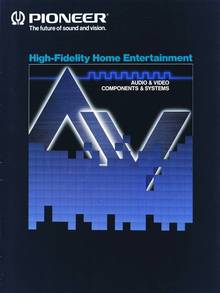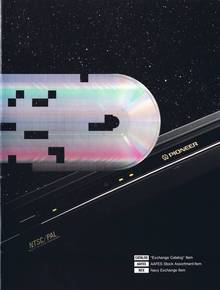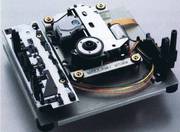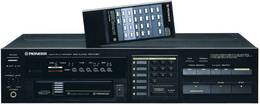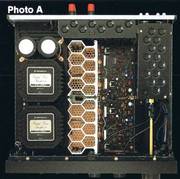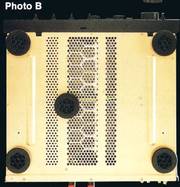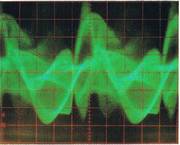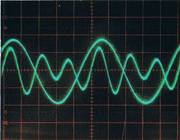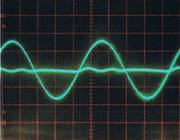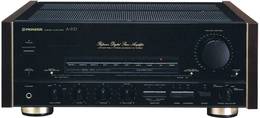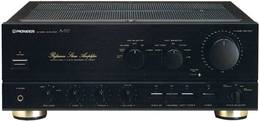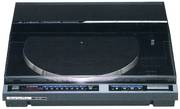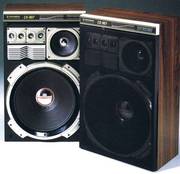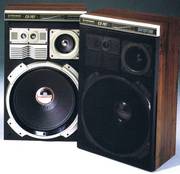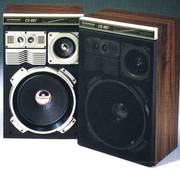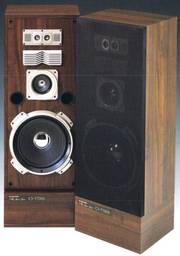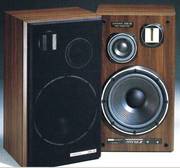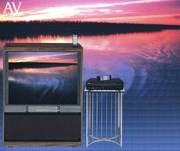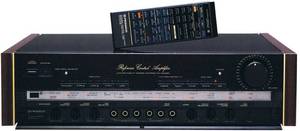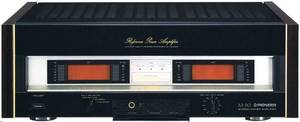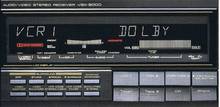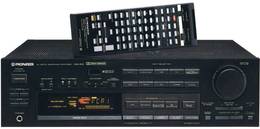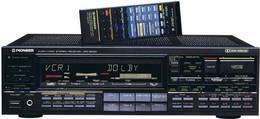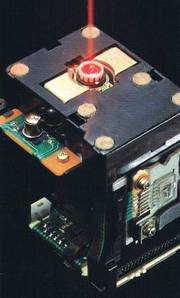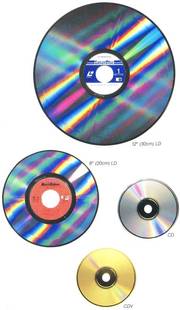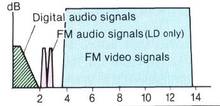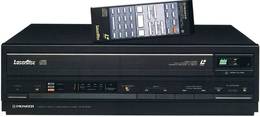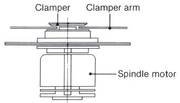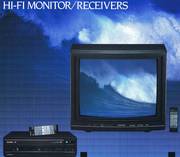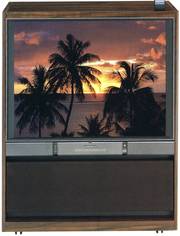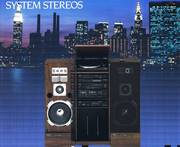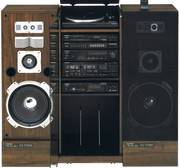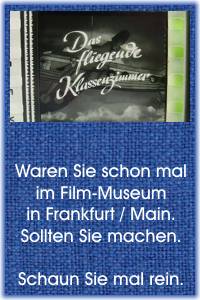Hier erhalten Sie einen Einblick in den amerikanischen Military-Prospekt von Pioneer (Juni 1987)
Dieser Spezial-Prospekt wurde ganz gezielt für die US-Soldaten und natürlich auch für die verbündeten Briten und Franzosen und Australier und Kanadier gemacht. Der Militärmarkt der teilweise sehr gelangweilten Soldaten und Angehörigen war nicht zu vernachlässigen.
Die US-Regierung bzw. die US-Militär-Administration unterstützte das Ganze auch mit einigen Tricks, um den um sich greifenden Rauschgift-Consum innerhalb der Armee und der Luftwaffe zu bekämpfen.
Die hier aufgeführten Audio- und Video-Produkte gab es fast nur in Japan, den USA und weltweit in speziellen Militäry-Shops. Diese Produkt-Typen wurden auf dem deutschen Markt nicht oder nur in Ausnahmen angeboten.
Solche Militär-Läden waren pseudo Military Shops oder Einrichtungen. Die amerikanischen "Audio-Clubs" durften nur beliefert werden, wenn die Preisfindungs-Regeln eingehalten wurden. Das bedeutete maximal 10% Aufschlag auf die "landed costs" ohne jeden Zoll und ohne jede Steuer. Damit war weder ein Importeur noch ein Vertrieb/Großhändler noch ein Einzelhändler in der Preisfindung "eingebunden".
Die US-Shops mußten den Gewinn ausschließlich und nachweislich für gemeinnützige soziale Zwecke innerhalb der US-Lokalität / Garnison verwenden. So entstand zum Beispiel der größte dieser Audio-Clubs hier in Wiesbaden im Stadtteil Mainz-Kastel.
Das war ein beeindruckendes Riesen-Hifi-Studio, eine große mehrstöckige Kaserne mit sehr sehr vielen einzelnen Räumen, welche personell von den Herstellern betreut wurden. Und dort gab es alles, wirklich alles, viel viel mehr als in diesem Prospekt zu sehen ist.
Ich durfte dort nur einmal reinschaun, etwas später wurde auch "die Mitnahme" von deutschen Gästen (Besuchern) zusammen mit US-Soldaten beendet.
Die Zielgruppe sind/waren die jungen Amerikaner im Militärdienst
Bei der Auswahl der gezeigten und beworbenen Produkte sind natürlich die jungen amerikanischen Soldaten im Fokus der Werbesprüche. Und in Amerika werden die jungen Leute von ganz früh an auf "Value" getrimmt. "Value" wird dabei im Sinne von "billig - billiger - am billigsten" verstanden. -
Bei uns gibt es da noch eine Diversifikation - genannt "preiswert". Aber auch hier bei uns in Deutschland wissen die Martkforscher, wenn irgendwo etwas von "Rabatt" oder "Discount" drauf steht, ist das Produkt so gut wie ausverkauft. In den US-Supermärkten gibt es Käse und Wurst mit der Aufschrift "value". Das ist dann die "unterste" (=billigste) Preiskategorie.
Die jetzt folgenden Modelle und Typen finden Sie auch fast nicht in irgendwelchen Europa-Prospekten von Pioneer. Sie müssen die Optik und die Specs schon ganz sorgfältig und genau vergleichen, um ähnliche Produkte zu identifizieren.
.
HIGH-FIDELITY HOME-ENTERTAINMENT
Audio & Video - Components & Systems
HI-FI & AV
The Future of Sound and Vision - Now!
Sure, technology in hi-fi audio-video is progressing a fantastic pace, and will certainly be more advanced tomorrow than it is today. But now is the time to buy. Why? Because the two most important innovations in the field - digital and laser - already have been introduced, and Pioneer already has put them to miraculous use in products with unparalleled performance, convenience and versatility.
In the following pages you will learn about our wide lineup of home-entertainment components and systems and some of the awesome things they can do - like deliver flawless, dynamic sound and picture-perfect visual reproduction. And while you're at it, you can learn how they do it, since we've given a basic technical explanation of all the "secrets" they contain, detailing many of the Pioneer-original digital and laser technologies that no one else can offer.
Yes, this is the time to make your buying decision, and make it on Pioneer, because it's our dedication to digital and laser technologies that brings you the future of sound and vision - now!
.
How "Hi" Is the "Fi"?
What is "hi-fi", after all? It's merely the concept of reproducing music with a high degree of fidelity to the original sound source. But, ah! How much fidelity do you really need before the sound resembles what you'd hear at a live concert or recital? Some would say the answer is found in the final listening. True. But it's also in the knowhow and, above all, the craftsmanship that go into a hi-fi component that determine whether it can recreate the thrill of "natural" sound. At Pioneer, we don't depend on electronic wizardry alone to overcome the barriers to faithful sound reproduction. Yes, we are known in the hi-fi field for our advanced and original technology. But far more rewarding to us is our reputation for putting that technology to work to make every Pioneer amplifier, tuner, CD player, cassette deck, turntable and speaker system the best it can be in terms of actual performance and user convenience. That's what "hi-fi" means to us - and when you enjoy the meaningful experience of hearing a Pioneer hi-fi product, you'll understand.
.
Compact Disc Players
.
All CD players do not sound alike, and Pioneer proves it. We've perfected very special techniques of eliminating sound-spoiling resonance, of reducing the need for electronic compensation of mistracking, and of converting digital data into the full drama and excitement for which CD sound is famed. All CD players aren't the same when it comes to convenience, either. And that's why we're offering six different models - three "PD-Ms" with multiplay - so you can choose the one you need.
.
Pioneer Invented 6-Disc "Multiplay" CD
That's right! Ours was the world's very first player of this type for consumer use. And, thanks to the knowhow we've acquired, we still lead the field. Benefits of multiplay are many, ranging from the convenience of six-disc ("6-pack") magazine loading to the luxury of seven hours twelve minutes of uninterrupted playback. Along the way are practical things like 32-track programming from all six discs, numerous repeat and others, and RANDOM PLAY in which a microcomputer selects the playlist from all loaded discs, or from only those programmed.
Anmerkung : Aber kein Wort davon, daß die Kiste beim Wechseln ganz fürchterlich rappelt.
.
For the Armchair Audiophile
Pioneer CD players with the "SR" mark come with a multifunctional Remote Control that puts all player functions at your fingertips. Also, be sure to check out the special MPSS* (Magazine Program Selection System) function of the Remote Control for the PD-M90X. Using the Remote Control anywhere, you can program up to 80 entries (selections and pauses) for eight "6-packs," push a button to transfer the program to the main unit, then sit back to enjoy the music. The controller has a display (see photo) to make programming and play easier.
Now, the Technical News
High-tech is more than just a highfalutin phrase in Pioneer CD. For example, we use the latest Digital Filter technology. Distortion is lower (weniger als was bitte ?), sound imaging is better (besser als was bitte ?), and thanks to the technique called "oversampling," frequency response is nearly ruler flat up to 20,000Hz. In the PD-7050, "4X Oversampling" means even less phase and harmonic distortion.
Kicking Out the Bad Vibes
One of the "miracles" of CD is electronic error correction of imperfect (or mistracked) discs. But this isn't always a good thing - especially when the microchips used in this clean-up process themselves emit RF (radio-frequency) vibes that can (and do!) interfere with the sound after it's been converted from digital to analog.
The surest way to get clean signals, therefore, is to reduce tracking errors in the first place. Toward this end, we've adopted an Anti-Vibration Design Policy for our CD players, and it consists of three important steps:
• First, we reduce disc vibration where it is strongest - right where the disc meets the spindle of the high-speed motor. Our New Disc Stabilizer clamps the disc magnetically to prevent passing on vibration.
• Next, we use a "ballast base" for the pickup. It is fully isolated from the main chassis by ceramic/rubber dampers and lowers the pickup's center of gravity for better stability.
• Then, our own research has led to a ribbed honeycomb construction for the entire player chassis, not only increasing rigidity but also protecting the pickup and drive from vibration generated by speakers and other external influences.
Sound like good ideas? They are -and they work!
.
More Good Ideas
• Digital Level Control: Microchips attenuate output volume digitally for smooth operation and highest fidelity for the life of the player.
• One-Touch Digital Fade: A specially designed IC protects sound quality while letting you fade music in and out at any time.
• Auto Program Editing: Helps you dub CDs (where law permits) by telling you the running time of programmed selections so you can easily know how many will fit on the cassette tape you use.
• Time Fade Editing: Similar to the above, this feature automatically fades out a tune during dubbing at the time-point you specify.
• "Music Window": This totally new feature lets you fade music in and out at any point; program up to eight fades (in/out) per disc.
• Direct and Add-On Programmed Play: While playing tracks in normal order, you can switch to programmed play directly, add on other programs and even program tracks while listening to them.
• 2-Speed Manual Search: Scan any CD audibly at 20 times normal speed or, inaudi-bly, at 60 times.
• MPSS is a trademark of Pioneer Electronic Corporation.
PD-M90X - Multi-Play Compact Disc Player
• Wireless Remote Control: Numeric keypad and liquid-crystal display increase versatility, while the Magazine Program Selection System (MPSS) lets you program up to 80 entries (selections and pauses) on the Remote Control, transfer the program to the main unit and enjoy music from any disc in 8 different "6-packs."
• Programmed Play: Enter your choice of up to 32 tracks from any or all six discs for automatic playback in the order you want.
• 6-Disc Magazine and Single-Disc Loader: Buy extra "6-packs" for your collection, and use single-disc loader like a conventional player's.
• "Random Play": Press the button and all tracks of discs in magazine (or single-disc loader) are played in random order selected by microprocessor; also, Random Play for 32 programmed selections.
• 7-Digit Fluorescent Display: Disc/track no. in play, elapsed time, etc.
• Anti-Vibration Design Policy: Copper-plated Honeycomb Chassis damps resonance and reduces need for error correction.
• Digital Filter: Cuts "loop noise" and reduces phase delay, distortion.
• Digital Output: Direct connections with outboard DAC (Digital-Analog Converter) unit or DAC-equipped amp (See Pioneer A-91D, page 10).
• Digital Level Control
• 6-Way Repeat
• Gold-Plated Output Terminals: Ensure maximum signal transfer to headphones, line out, etc.
• Timer Start
• 2-Speed Manual Search ¦Subcode Output
• Elegant Looks: Front panel of solid aluminum has lacquer-like luster; thick side panels have attractive wood-grain look.
JD-M100 - Multi-Play Magazine
Call it a "6-pack" if you like - it's just as handy, and even more fun. One is provided with each Pioneer multiplay CD player, and spares are available at option. Build your own home CD library -jazz in one, classical in another, rock or CW or anything else in still others. Pop in a "6-pack," sit back to enjoy full access to all tracks on all six discs.
PD-M60 - Multi-Play Compact Disc Player
• Wireless Remote Control: Numeric keypad included.
• Programmed Play: Enter your choice of up to 32 tracks from any or all six discs for automatic playback in the order you want.
• 6-Disc Magazine and Single-Disc Loader: Buy extra "6-packs" for your collection, and use single-disc loader like a conventional player's.
• "Random Play": Press the button and all tracks of discs in magazine (or single-disc loader) are played in random order selected by microprocessor; also, Random Play for 32 programmed selections.
• 7-Digit Fluorescent Display: Disc/track no. in play, elapsed time, accumulated program time, etc.
• Anti-Vibration Design Policy: Honeycomb Chassis damps resonance and reduces need for error correction.
• Digital Filter: Cuts "loop noise" and reduces phase delay, distortion.
• 6-Way Repeat: All six discs, programmed tracks, a single disc, etc.
• Gold-Plated Output Terminals: Ensure maximum signal transfer to headphones, line out, etc.
• Headphone Output with Volume Control ¦Timer Start
• 2-Speed Manual Search
• Subcode Output
.
PD-M50 - Multi-Play Compact Disc Player
• Wireless Remote Control: Numeric keypad included.
• Programmed Play: Enter your choice of up to 32 tracks from any or all six discs for automatic playback in the order
you want.
• 6-Disc Magazine and Single-Disc Loader: Buy extra "6-packs" for your collection, and use single-disc loader like a conventional player's.
• "Random Play": Press the button and all tracks of discs in magazine (or single-disc loader) are played in random order selected by microprocessor; also, Random Play for 32 programmed selections.
• 7-Digit Fluorescent Display: Disc/track no. in play, elapsed time, etc.
• Anti-Vibration Design Policy: Honeycomb Chassis damps resonance and reduces need for error correction.
• Digital Filter: Cuts "loop noise" and reduces phase delay, distortion.
• 5-Way Repeat: All six discs, programmed tracks, or a single disc, etc.
• Headphone Output with Volume Control ¦Timer Start
• 2-Speed Manual Search
.
PD-7050 - Compact Disc Player
• 4X Oversampling Digital Filter: For
clear sound and well-defined image.
• Anti-Vibration Design Policy: New Disc Stabilizer, "Ballast Base" for Pickup and Honeycomb Chassis damp resonance.
• Wireless Remote Control
• Twin D/A Converters: Glitch-free circuit design reduces phase distortion and crosstalk for clear sound and precise images.
• Four Independent Power Supplies: Interference is reduced by separating supplies for servo control, D/A converter, analog audio and display.
• Random Programmed Play: For up to 24 tracks.
• Auto Program Editing, Add-On Programmed Play and Direct Programming
• Time Fade Editing, "Music Window" and One-Touch Digital Fade
• Digital Level Control
• Digital Output
• 3-Way Search and 3-Way Repeat
• 8-Digit Fluorescent Display
• Headphone Output with Volume Control
• Timer Start
.
PD-6050 - Compact Disc Player
• Digital Filter: For clear sound and well-defined image.
• New Disc Stabilizer: Magnetic clamper improves tracking by reducing vibration.
• Honeycomb Base: For more chassis rigidity to protect pickup from vibration and acoustic feedback.
• Vibration-Resistant Pickup Mechanism: For better isolation from the chassis and higher stability thanks to new "Ballast Base" design.
• Wireless Remote Control
• Random Program Play of 24 Tracks ¦Auto Program Editing
• Add-On Program Play and Direct Programming: Switch to programmed play with no pause, or program as you play.
• 2-Way Search: Track and 2-speed manual.
• 3-Way Repeat: All tracks, programmed tracks and a single track.
• 8-Digit Fluorescent Display
• Headphone Output with Volume Control
• Timer Start
.
PD-4050 - Compact Disc Player
• Digital Filter: For clear sound and well-defined image.
• New Disc Stabilizer: Magnetic clamper improves tracking by reducing vibration.
• Honeycomb Base: Stiffens chassis to guard pickup from vibration and acoustic feedback.
• Vibration-Resistant Pickup Mechanism: Isolated from chassis for higher stability thanks to new "Ballast Base" design.
• Random Programmed Play: Up to 16 tracks
• 2-Way Search: Track and 2-speed manual.
• 3-Way Repeat: All tracks, programmed tracks and single track.
• Track Display
• Timer Start
.
Amplifiers & Tuners
.
What do they do, these mysterious black boxes with all the different switches and symbols? It isn't really necessary to understand exactly how they work to enjoy them, but a general understanding of why some work better than others can't hurt, right? So, the following covers a few Pioneer-exclusive technologies and techniques for better performance.
.
Anti-Vibration & Short-Path Design
Sound is a series of vibrations. Until it is reproduced as soundwaves, it's in the form of rather weak electrical signals which, if exposed to unwanted vibrations or interference inside your amp, tuner or other component, can be easily damaged.
Pioneer's long experience in hi-fi (we'll be 50 in 1988) has led to our "Anti-Vibration" and "Short-Path" design policies, which include some of the following points:
• Honeycomb Stiffeners: As in our latest CD players and other components, the Pioneer amplifiers and tuners introduced in this catalog make use of a new, ribbed "honeycomb" design in the materials used in key points - such as the chassis, chassis separators, heat sinks, etc. It increases rigidity and discourages internal and external vibration.
• Shielded Circuitry: Wherever possible, individual blocks have been separated from their neighbors by thick, diecast aluminum cases, especially where physical and/or electronic/magnetic emissions, such as from the power supply, could endanger sound purity.
• Short-Path Routing: Also wherever pos-sible (even when it means relocating a front-panel switch or two), the working circuits inside each component are positioned so as to shorten the overall length of the path the signals must travel from input to output.
.
Dynamite with Digital!
All three Pioneer integrated amplifiers have our exclusive Non-Switching* power outputs, eliminating switching distortion; in the latest Type III version, distortion is further reduced to 1/50 the original value, and thermal distortion is reduced to absolute zero, an important point when low-impedance drive capability is a priority. All three amps also handle the analog sound signals derived from CD and other PCM sources with masterful ease, delivering all the awesome dynamic range and extremely wide frequency response of digital.
In the A-91D, digital design is taken several steps further - resulting in on-board D/A direct digital inputs, including one that permits optical connection, the use of a digital filter having 4x oversampling capabilities to eliminate "loop noise" generated in the harmonics of the sampling frequency, and dedicated glitch-free Twin D/A Converter circuitry that transforms digital signals to analog in the right and left channels independently without phase delay. Non-digital circuits are turned off to prevent interference when digital sources are in play.
* Non-Switching is a trademark of Pioneer Electronic Corporation.
In Tune with the Times
Has radio broadcasting improved lately? No, because it's always been good, technically speaking. But only lately have tuners been able to take advantage of the high quality available, and Pioneer technologies such as synthesized tuning in the F-91 and F-551 lead the way. In the F-91 in particular, we use a new Digital Direct Decoder Type III to further enhance performance. In it, the IF output is converted into a digital signal by a pulse converter; because it remains digitized until it is separated into the left and right audio signals, noise and distortion can't touch it. Every tuner specification is dramatically improved (example: the stereo S/N is a high 87dB).
ARTS Cleans Up Your Act
Pioneer's new Active Real-Time Tracing System - ARTS for short - helps the F-91 deliver clean and optimum signal reception. It replaces the "WIDE/NARROW" filtering technique in which the WIDE position provided better sound quality at the expense of selectivity and, conversely, the NARROW position provided better selectivity at the expense of sound quality (see oscillophotos). Using a kind of "servo-filtering," its IF filter circuit "tracks" the tuned frequency in real time, eliminating interference ONLY where it actually exists, thus providing optimum sound quality AND selectivity.
A-91D - Reference Digital Integrated Amplifier
• Continuous average power output of 120 watts* per channel, min., at 8 ohms, from 20Hz to 20,000Hz with no more than 0.003% total harmonic distortion (150 watts* at 4 ohms with 0.005% THD)
• Direct Digital Input: Accepts data directly from CD or other PCM source via both electrical and optical carriers.
• 4X Oversampling Digital Filter
• Twin D/A Converters: Glitch-free circuitry in each channel to reduce phase distortion and crosstalk for deep, clear sound with natural imaging.
• Non-Switching** Circuit Type III: Ends switching distortion, improves linearity, thermal stability and low-impedance handling.
• Separate Voltage-/Output-Amp Stages: Ensuring consistent performance regardless of load variations.
• Separate Circuit Blocks and Shortest Signal Paths: Protection from noise, intermodulation distortion and other sound-spoiling factors.
• Anti-Vibration Design: Honeycombed material defeats local resonance in chassis, chassis-separators and heat sinks.
• Two High-Capacity Transformers: Low-impedance loads get the power they need from these units in finned, solid diecast cases.
• 6 Analog and 4 Digital Inputs: Including one for optical connection.
• D/A REC Selectors: Send digital or analog sound to any connected recorder.
• "Hybrid" Booster for MC Cartridges
• Automatic Power On/Off: For digital, tone control and phono circuits.
• Gold-Plated Phono and CD Inputs
* Measured pursuant to the Federal Trade Commission's Trade Regulation Rule on Power Output Claims for Amplifiers.
** Non-Switching is a trademark of Pioneer Electronic Corporation.
F-91 - Reference Digital Synthesizer Tuner
• Pioneer's ARTS (Active Real-Time Tracing System): Tuned frequency is followed in real time by IF filter circuit to eliminate interference and pass on purest possible signal to audio output.
• Pioneer's Digital Direct Decoder Type III: Every major tuner specification is improved through digital processing combined with direct conversion from FM to left/right audio output.
• Anti-Vibration Design: Honeycombed material and large insulators defeat resonance in chassis and other parts for cleaner sound.
• ID MOS FET in FM Front End: Enables lower noise and distortion, higher sensitivity and better interference rejection.
• Random Presets for 24 FM/AM Stations: Preset and recall favorite stations at a touch.
• Auto Level Indicator
• REC Level Check: A must when recording off the air.
• 3-Step Muting
• 3-Station Timer Programming
• Large Fluorescent Display
A-717 - Non-Switching™ Integrated Amplifier
• Continuous average power output of 100 watts* per channel, min., at 8 ohms, from 20Hz to 20,000Hz with no more than 0.003% total harmonic distortion (140 watts* at 4 ohms with 0.005% THD)
• Non-Switching™ Circuit Type III: Ends switching distortion, improves linearity, thermal stability and low-impedance handling.
• Separate Voltage-/Output-Amp Stages: Ensuring consistent performance regardless of load variations.
• Separate Circuit Blocks: High-quality construction lessens noise, etc.
• Direct Connection: Short-path design for the purest possible sound.
• Anti-Vibration Design: Honeycombed material defeats local resonance in chassis, chassis-separators and heat sinks.
• High-Capacity Twin Transformers: Clarity is preserved since separate design and solid diecast cases damp resonance and lower magnetic flux.
• "SOURCE DIRECT" Switch: Puts all secondary circuits except volume off-line to ensure purest sound possible.
• 8 Inputs: CD, TAPE, PHONO, etc.
• High-Gain Phono Equalizer
• Independent Power Switch for Phono
• Gold-Plated Phono and CD Inputs
.
A-616 - Non-Switching™ Integrated Amplifier
• Continuous average power output of 80 watts* per channel, min., at 8 ohms, from 20Hz to 20,000Hz with no more than 0.005% total harmonic distortion (100 watts* at 4 ohms with 0.008% THD)
• Non-Switching™ Circuit Type II: Ends switching distortion, improves linearity and thermal stability.
• Separate Voltage-/Output-Amp Stages: Ensuring consistent performance regardless of load variations.
• Separate Circuit Blocks: High-quality construction lessens noise, etc.
• Direct Connection: Short-path design protects sound purity.
• Anti-Vibration Design: Honeycombed material defeats local resonance in chassis, chassis-separators and heat sinks.
• High-Capacity Twin Transformers
• "SOURCE DIRECT" Switch: Puts all secondary circuits except volume off-line to ensure purest sound possible.
• 8 Inputs: CD, TAPE, PHONO, etc.
• High-Gain Phono Equalizer
• Gold-Plated Phono and CD Inputs
.
F-551 - Quartz-PLL FM/AM Tuner
• Pioneer CCTS (Computer-Controlled Tuning System): Automatically minimizes tracking error for lower noise and distortion; the hi-blend circuit activates to reduce stereo noise when the signal is weak.
• Three-Speed Search: Touch once for automatic scan/tuning of each tunable station; hold down to scan/tune only the
most powerful stations; a sustained touch quickens the search speed.
• Random Presets for 24 FM/AM Stations: Preset and recall favorite stations at a touch.
• Digital Readout of Signal Strength
• Digital Frequency Display
.
Cassette Decks
.
CT-1380WR - Twin Quick Auto-Reverse Cassette Deck
• Two Quick Auto-Reverse REC/PLAY Cassette Transports:
Taping has never been easier.
• Wireless Remote Control: Numeric keypad included.
• Random Access Programming: Play the song you want -now.
• Parallel Recording: Record two tapes at once.
• Dubbing and Programmed Dubbing: At normal or high speed.
• Relay REC/PLAY: Record or play second tape when first ends.
• Full-Logic Tape Transports: Comfortable and jam-free.
• Dolby* B/C Noise Reduction: Lowers "hiss,'' preserves dynamic range.
• Auto REC Mute: Records "cue-blanks" between songs.
• Music/Skip Search: Skip up to 10 songs.
.
CT-1280WR - Double Auto-Reverse Cassette Deck
• Two Auto-Reverse Cassette Transports: One plays, the other records and plays.
• Tape Dubbing: Synchro Start for normal or double speed recording.
• Relay Play: Play automatically continues from one tape to next.
• dbx** Noise Reduction: Expands dynamic range to 110dB and improves the signal-to-noise ratio to 92dB.
• Dolby B/C Noise Reduction: Lowers "hiss,'' preserves dynamic range.
• Auto REC Mute: Records "cue-blanks" between songs.
• Music/Skip Search: Skip up to 10 songs.
• Blank Skip
• Timer-Controlled REC (Deck II) and Play (Deck l/ll)
• Auto Tape Selector
* "Dolby" and the double-D symbol are trademarks of Dolby Laboratories Licensing Corporation.
*dbx is a trademark of dbx, Inc.
.
CT-3080R - Quick Auto-Reverse Cassette Deck
• Quick Auto-Reverse Cassette Transport: Automatic REC/ PLAY both sides.
• Random Access Programming: Play the song you want -now.
• dbx Noise Reduction: Expands dynamic range to 110dB and improves the signal-to-noise ratio to 92dB.
• Dolby B/C Noise Reduction
• Oversized Fluorescent Display and 4-Digit Tape Counter
• REC Mute: To add "cue-blanks" between songs.
• Music Search and Skip Reverse ¦Timer-Controlled Recording and Play
• Slider Recording Level Control ¦Auto Tape Selector
• "SR" Remote Control Terminal
.
CT-2080R - Quick Auto-Reverse Cassette Deck
• Quick Auto-Reverse Cassette Transport: Automatic REC/ PLAY both sides.
• Full-Logic Tape Transport: Comfortable and jam-free.
• dbx Noise Reduction: Expands dynamic range to 110dB and improves the signal-to-noise ratio to 92dB.
• Dolby B/C Noise Reduction
• Music Search: Quickly finds the song you want.
• One-Touch Recording
• REC Mute: To add "cue-blanks" between songs.
• LED Level Meter for each channel
.
Turntables
.
PL-88FS(BK) - Programmable Front-Loading Turntable
• Stackable Front-Loading Design
• Computer Programmed Automatic Operation:
Programmed Play, Index Scan, Skip Play and Repeat Play.
• Quartz-PLL Servo System
• Coreless DC Direct-Drive Motor with Stable Hanging Rotor
• High-Output MC Cartridge (PC-41MC)
* Stable Hanging Rotor is a trademark of Pioneer Electronic Corporation.
.
PL-L70 - Programmable Linear-Tracking Turntable
• Computer Programmed Automatic Operation:
Programmed Play Skip Play and Repeat Play made easy with a microcomputer and a precise optical music sensor.
• Dynamic Resonance Absorber (DRA): Eliminates resonance-induced vibration in tone arm.
• Linear Tracking: Better sound definition because tracking error is reduced.
• "Flat-Torque" Coreless Quartz-PLL Direct-Drive Motor: Smooth, stable platter rotation. Pioneer Stable Hanging Rotor* reduces spindle wobble.
• Automatic Disc Size/Speed Selector
• Manual Cueing Controls
.
- Anmerkung : Beide Plattenspieler waren - wie auch die vier Cassettenrecorder oben drüber - am untersten Qualitäts-Rand angesiedelt. Doch das spielte für diese Zielgruppe überhaupt keine Rolle. Es mußte billig sein.
.
Speaker Systems
.
CS-907
4-Way Bass Reflex Speaker System with 15-3/4" Woofer
• Extra-Large 15-3/4" (40cm) Woofer with EBD (Electronic Bass Drive): Efficient reproduction of crisp lows down to 30Hz thanks to heat-resistant voice coil and a large strontium ferrite magnet.
• 6-1/2" (16cm) Cone Midrange: Large magnet and high-temperature voice coil "sweeten" vocals and other sounds in the mid-frequency range.
• Horn Tweeter: Disperses highs evenly throughout your room through its acoustic lens; a self-restoring protection circuit prevents voice-coil burnout.
• Four Piezoelectric Supertweeters: Power and realism are enhanced by extending high-frequency response beyond the audible range.
• Three Tone Selectors: Normal, Soft and Crisp
• 13-LED Power Indicators
• Wide Frequency Response: 30Hz - 25,000Hz
• High Power Capability: 400 watts (max.)
CS-707
4-Way Bass Reflex Speaker System with 15-3/4" Woofer
• Extra-Large 15-3/4" (40cm) Woofer with EBD (Electronic Bass Drive): Efficient reproduction of crisp lows down to 30Hz thanks to heat-resistant voice coil and a large strontium ferrite magnet.
• 4-3/4" (12cm) Cone Midrange: Large strontium ferrite magnet for high power and convincing sound.
• Horn Tweeter: Disperses highs evenly throughout your room through its acoustic lens; a self-restoring protection circuit prevents voice-coil burnout.
• Twin Piezoelectric Supertweeters: Power and realism are enhanced by extending high-frequency response beyond the audible range.
• Three Tone Selectors: Normal, Soft and Crisp
• 11-LED Power Indicators
• Wide Frequency Response: 30Hz - 25000Hz
• High Power Capability: 300 watts (max.)
.
CS-607
4-Way Bass Reflex Speaker System with 12" Woofer
• Large 12" (30cm) Woofer with EBD (Electronic Bass Drive): Pioneer-exclusive EBD and large, powerful magnet provide crisp and gutsy lows down to 35Hz.
• 4-3/4" (12cm) Cone Midrange: Large strontium ferrite magnet for high power and convincing sound.
• Horn Tweeter: Disperses highs evenly throughout your room through its acoustic lens; a self-restoring protection circuit prevents voice-coil burnout.
• Twin Piezoelectric Supertweeters: Power and realism are enhanced by extending high-frequency response beyond the audible range.
• 11-LED Power Indicators
• Wide Frequency Response: 35Hz - 25,000Hz
• High Power Capability: 210 watts (max.).
.
CS-T7000
4-Way Bass Reflex Speaker System with 12" Woofer
• Large 12" (30cm) Cone Woofer: Coupled by resonant air column to large enclosure for rich lows extended down to 30Hz.
• 4-3/4" (12cm) Cone Midrange: Delivers smooth mids for natural vocals and other sounds in the mid-frequency range.
• Horn Tweeter: Disperses highs evenly throughout your room through its acoustic lens; a self-restoring protection circuit prevents voice-coil burnout.
• Two 1-5/8" (4.2cm) Cone Supertweeters: Extend high-frequency response for wide-range and clear sound reproduction.
• High-Profile Design: "Tall-boy" size meets height of SYSTEM CD90 and SYSTEM CD70.
• High Power Capability: 210 watts (max.) high-power handling capacity.
DSS-9D
3-Way Bass Reflex Speaker System with 12 Woofer
• PG Cone Woofer (12"/30cm): With excellent transient response, distortion is minimal.
• Boron Cone Midrange (4-3/4"/12cm): Improved frequency response and extended dynamic range.
• Pioneer Beryllium Ribbon Tweeter: Better transient response, lower distortion.
• Linear-Drive Magnet Circuit: Retains natural sense of presence from softest to loudest sounds.
• Dynamic Response Suspension: Woofer "tracks" dynamic changes in the input level more accurately.
• Electronic Bass Drive: Extends bass response.
• Round Cornered Baffle: No sharp edges to blurr stereo image.
• Tone Selectors for Mids and Highs
• High Power Capability: 300 watts (max.), 80 watts (rated).
.
- Anmerkung : Auch hier wieder - je größer, desto besser, aber immer im LowCost Bereich angesiedelt. Auch optisch mußten die Boxen "etwas her machen".
.
S-X7
Surround-Sound Speaker System
• Compact and Lightweight (3 lbs. 5 oz./1.5kg). ¦Wide Installation Versatility: Hang on wall or ceiling as
required by your seating position when enjoying surround sound programs.
• 3-1/2" (8.7cm) Full-Range Speaker
• Power Capability: 45 watts (max. music power).
Turning AV into a Class Act
Remember when teacher used to pull down the blinds, dim the lights and crank up that noisy projector? Seeing "How Earthquakes Happen" or "The Persian Empire and Why It Fell" was guaranteed to put us to sleep for the rest of the period. That was called "AV" - which then meant "audio-visual". Exactly when "AV" started to mean "audio-video" and shed its schoolroom image isn't known. But we do know that modern, high-tech AV is and will likely remain the most exciting form of home entertainment (and education, come to think of it) for a long time to
come. With LaserVision (LD), high-quality VCRs, cable-TV and so many other program sources so affordably available today, we are no longer prisoners of "free" broadcast TV. However, it's not enough just to own a little-bit bigger TV or jury-rig the TV audio through your ancient stereo. Needed instead - and what we at Pioneer are dedicated to bringing you - is a whole new array of AV products delivering total AV enjoyment with high fidelity in both audio and video. And that's exactly what the products in the next few pages do - with a big measure of class!
.
AV Reference Amplifiers
.
C-90(BK) - Reference Control Amplifier
• "Mono x Two" Design Concept: Audio circuitry in the respective channels is entirely separated, independently grounded, and individually supplied with power from separate windings on one of the two power transformers.
• Audio/Video Independence: Circuitry for video-only use is well isolated from other parts, and fed power from a transformer dedicated to video/display functions.
• Short-Path Design: Lessens the chance that tiniest electrical and magnetic radiation within can harm the delicate signals.
• Copper-Plated Chassis and Screws: Reduce magnetic distortion.
• "Hybrid" MC Transformer/Phono Amp: For flat response and less noise.
• Motorized Volume Control: Provides smooth, notch-free, non-electronic control of output level (volume) from Remote Controller.
• 6 Audio and Video Inputs: CD, phono, tuner, two decks and adaptor (audio) and an LD player, three VCRs, TV/Video and adaptor (video).
• Video Outputs: Two monitor outputs, and a 5-pin RF converter output.
• REC Selector: Offers wide flexibility in recording/dubbing, such as taping a video source with an independent audio source, and independent use of adaptors (audio/video) while recording.
• Dubbing Circuits (Audio): Dub between Deck A and Deck B in either direction, or record audio portion of any video source.
• Dubbing Circuits (Video): Dub TV/VDP to any or all three connected VCRs (Parallel Copy) with video-and-audio, video-only or audio-only; Two-Way Dubbing from any of three VCRs to either or both of the others; dubbing can be made while viewing/listening to other programs.
• Video Enhancer: Switch on to enhance any video signal sent to monitor(s) and/or connected decks for recording/dubbing. Sharpness, Detail and Noise Reduction controls are provided.
• Luxurious Finish: Thick aluminum front panel with deep black, lacquer-like luster, gold-toned highlights and beautiful rosewood-grained side panels, matching M-90.
.
M-90(BK) - Reference Power Amplifier
• Continuous average power output of 200 watts* per channel, min., at 8 ohms, from 20Hz to 20,000Hz with no more than 0.003% total harmonic distortion: Can Deliver dynamic power of 800 watts at 2 ohms (with EIA dynamic test signal).
• "Mono x Two" Design Concept: Each channel is treated like a single, monophonic line from input to output. Each has its own power supply, very large, heavy transformer, transistor bank, heat sink, etc. To handle massive current flow, high-electrolytic capacitors (total 48,000|jF) offer a capacity of as much as 47A of current.
• Low-Impedance Drive: Improves response accuracy when sharp-attack signals are present, such as when playing digital sources.
• Short-Path Design: Lessens the chance that tiniest electrical and magnetic radiation within can harm the delicate signals.
• Non-Switching™ Type II: Stabilizes idling current fluctuation and suppresses distortion to 1/30th usual.
• Direct Input for CD: Analog signal can be sent directly to power-amplification stages via input on back panel.
• Volume Control for CD: Also "short-path" in design, it is linked to potentiometer behind the input terminals via a stiff shaft.
• CD Output Loop: Route CD input back to any connected pre-amp for listening/recording.
• Luxurious Finish: Thick aluminum front panel with deep black, lacquer-like luster, gold-colored highlights, large power indicators and beautiful rosewood-grained side panels, matching C-90.
* Measured pursuant to the Federal Trade Commission's Trade Regulation Rule on Power Output Claims for Amplifiers.
.
AV Amplifier & Receivers
.
They may look complicated at first, but be assured we've gone to extraordinary lengths to make the operation of these totally AV amps and receivers quite easy and "human." The VSA-910 AV amplifier and the three VSX receivers in these pages all incorporate special video functions. On the audio side, too, special functions are provided to complete the AV concept. Then, with Non-Switching™ Type II outputs and built-in Surround Sound amplifiers and processing circuits in all but the VSX-3000, there's even more to enjoy.
.
Getting the Picture
In addition to versatile audio inputs for CD, Phono, etc., the VSA-910 and all three AV receivers also offer inputs and in/out dubbing circuits for video components, including an LD player and at least two VCRs. They also output a pure video signal to any NTSC-standard monitor for display; a 5-pin DIN socket accepts an optional RF modulator (JA-RF5) to send a composite video/audio signal to a conventional TV's tuner.
What You See Is What You Choose
A handy feature called a "Video Selector" is provided on all Pioneer AV amps/receivers to let you send your choice of video signals to the screen, regardless of what audio you are hearing - a real convenience when viewing or recording a simulcast, or when creating your own "after-recording" or composite videos.
Don't Like It? Enhance It!
The most-often used technique to improve picture quality is called "enhancing," which boosts the brightness for better viewing. Variable enhancing is possible both during direct viewing and dubbing in the VSX-50007 4000(BK) and VSA-910. Moreover, in all three components it combines with Split-Screen to display, if you wish, the non-enhanced picture on one half of your screen, the enhanced one on the other half.
The Sensation of Surround
Surround-sound processing, known under various names these days, is the latest AV sensation, and no wonder! Imagine hearing sounds come from the sides, back and even above as you watch the action on the screen - much as in a movie theater or at a concert. "Dolby Surround" is offered in the VSA-910 and VSX-5000 to handle the "real thing" encoded in certain videos, while other Surround, Simulated Stereo and related functions are found on those two components, as well as on the VSX-4000 and VSX-3000 (please refer to specific component) to simulate still other all-encompasing sound fields in your own living room.
.
Tuning Takes Just a Touch
With the accuracy of Quartz-PLL digital synthesized tuning in all three of our AV receivers comes the added convenience of instant recall of 20 of your favorite FM and AM stations. Presetting is especially easy with the Station Call keys on the VSX-5000 and VSX-4000, allowing direct punch-in for station frequencies. You can even assign them four-digit alphanumeric codes, such as POP1, NEWS or JAZZ, shown on the large liquid-crystal display panel every time you recall them. All three Pioneer AV receivers also have direct inputs for Cable-FM leads and presetting.
.
Thanks for the Acoustic Memory
Tone control settings you enter for bass and treble can also be preset in the VSA-910, VSX-5000 and VSX-4000 with the "Acoustic Memory" function. And not just one pair of settings, but three.
Let Your Fingers Do the AV-ing
Integrate any Pioneer amplifier or receiver with other Pioneer audio-video components bearing the "SR" (System Remote) mark and enjoy remote control of the main functions of the equipment shown above from a single "SR" unit. This is particularly convenient with the remote units provided with the VSX-5000 and VSX-4000 audio-video receivers, which are full-function types that include a +/- button for Surround Sound volume. Even more versatile is the "smart" Remote Control included with the VSA-910.
.
VSA-910 - Audio/Video Surround Amplifier with Digital Delay
• Stereo mode: Continuous average power output of 100 watts* per channel, min., at 8 ohms, from 20Hz to 20,000Hz with no more than 0.005% total harmonic distortion.
• Surround mode: Continuous average power output of 70 watts* per channel, min., at 8 ohms, from 20Hz to 20,000Hz with no more than 0.005% total harmonic distortion (front); 30 watts* per channel, min. at 8 ohms, from 20Hz to 20,000Hz with no more than 0.08% total harmonic distortion (surround).
• Non-Switching™ Circuit Type II: Ends switching distortion, improves linearity and provides constant performance under varying temperature conditions for cleaner sound.
• Built-in Surround-Sound Processor: DOLBY SURROUND, STADIUM and SIMULATED SURROUND.
• Digital Delay Circuit: Three delay positions are provided. Digital processor ensures low-noise performance.
• 4 Video Inputs: Inputs for LD player, TV, VCR-1 and VCR-2, plus Adaptor in/output; dubbing is possible between VCRs, or from LD player to VCR.
• Audio Inputs: CD, PHONO, DAT, TAPE.
• Video Enhancer with Split Screen: Brighter picture for
viewing and dubbing; compare enhanced with non-enhanced
picture on same screen. ¦Acoustic Memory: Set three different bass/treble curves and
recall any at a touch.
• Super Bass: Deepens acoustic field by enhancing low bass frequencies.
• On-Screen Display: Operational status of the amplifier at a glance.
• Large Multifunction Fluorescent Display
* Measured pursuant to the Federal Trade Commission's Trade Regulation Rule on Power Output Claims for Amplifiers.
.
At Last - A "Smart" A/V Remote Commander
The VSA-910's 67-key "smart" Remote Commander handles virtually every function of the VSA-910, gives you fingertip command of the major functions of other Pioneer "SR" components and - a big bonus! - of the major functions of many non-Pioneer components:
LEARNING: It's easy to "teach" the Remote Commander the infrared codes for remote control of other AUDIO, VIDEO and AUXILIARY home-entertainment components, including VCRs, TVs and others. Just place it head to head near the other remote and let it "learn" the desired functions.
A/V: Keys are provided to control virtually all of the play, recording, pause, f-fwd/rew, track/band/channel/ station and other capabilities of CD and analog record players, DAT and analog cassette decks, tuners and AUX units, LD players, VCRs and even TVs.
VOLUME: "Master Volume" commands overall sound-level output from the VSA-910, while the 6-key Surround array controls L/R and F/R balance in the Surround Mode. The Surround Mode button selects Dolby Surround, Stadium, Simulated Surround, and Off, and the Delay Time button calls up four delay intervals (15us, 20us, 30us, 40us) and Off.
VSX-5000(BK) - Audio/Video Quartz-Synthesizer Receiver with Non-Switching™ Amp
• Stereo mode: Continuous average power output of 100 watts* per channel, min., at 8 ohms, from 20Hz to 20,000Hz with no more than 0.005% total harmonic distortion.
• Surround mode: Continuous average power output of 70 watts* per channel, min., at 8 ohms from 20Hz to 20,000Hz with no more than 0.005% total harmonic distortion (front); 15 watts* per channel, min., at 8 ohms, from 20Hz to 15,000Hz with no more than 0.3% total harmonic distortion (surround).
• Full-Function "SR" Remote Control
• 4 Video Inputs: 2 VCRs, 1 LD player and 1 video adaptor.
• Video Signal Selector
• Cable FM Input
• Surround: Studio, Stadium, Dolby.
• Simulated Stereo/Dynamic Expander
• Video Enhancer with Split Screen
• Acoustic Memory
• Non-Switching™ Circuit Type II
• Random Preset of 20 FM/AM Stations
• 60/30-Minute Sleep Timer
.
- Anmerkung : Ein damals nach USA zurückkehrender Amerikaner hatte mir seinen VSX-5000 überlassen, denn der hatte nach 2 Jahren schon Aussetzer. Es war eine kalte Lötstelle auf einem Vorverstärker Board. Trotz der gemessenen 2 x 110 Watt Dauerleistung mußte ich feststellen, dieser Receiver klingt bei mir an meinem Boxen einfach nicht - mit oder ohne Klangregelung und mit oder ohne Loudness. Es kostet viel Zeit, herauszufinden, mit welchen Boxen der Receiver wirklich klingt, vielleicht mit japanischen Boxen wie damals bei dem Amerikaner.
.
VSX-4000(BK) - Audio/Video Quartz-Synthesizer Receiver with Non-Switching™ Amp
• Continuous average power output of 60 watts* per channel, min., at 8 ohms, from 20Hz to 20,000Hz with no more than 0.007% total harmonic distortion.
• Full-Function "SR" Remote Control
• 3 Video Inputs: 2 VCRs and 1 LD player, with two-way dubbing and monitor.
• Video Signal Selector
• Cable FM Input
• Station ID Display: Large LCD.
• Simulated Stereo and Stereo Wide: Add more excitement to video watching.
• Speaker Matrix Surround ¦Video Enhancer with Split Screen • Acoustic Memory
• Non-Switching™ Circuit Type II
• Random Preset of 20 FM/AM Stations
• 60/30-Minute Sleep Timer
.
VSX-3000 - Audio/Video Quartz-Synthesizer Receiver
• Continuous average power output of 60 watts* per channel, min., at 8 ohms, from 20Hz to 20,000Hz with no more than 0.05% total harmonic distortion.
• Full-Function "SR" Remote Control
• 3 Video Inputs: 2 VCRs and 1 LD player, with two-way dubbing and monitor.
• 5-Band Graphic Equalizer: Tailor the tonal "shape" of your music.
• Ready for Surround: Outputs ready for a matrix surround hookup.
• Simulated Stereo: A "stereo" effect from mono programs.
• Two FM Antenna Inputs ¦Audio Noise Filter ¦Video Signal Selector
• Random Preset of 20 FM/AM Stations
• Clock, Programmable Timer, 60/30-Minute Sleep Timer
.
LaserVision Players
.
Pioneer's original contributions to the miracle of sound and vision called LaserVision (LD) have raised the performance quality and user convenience of the medium far beyond even the most fanciful expectations.
There is absolutely no other audio/video program source capable of delivering a richer, truer picture or more dynamic and accurate sound to the home user today.
- Anmerkung : Also das Video-Bild ist jetzt "richer and truer" = reicher und wahrer ??? Was soll das bedeuten ? Wenn man genauer liest und übersetzt, findet man noch viel mehr Unsinn.
Also, like Compact Disc, LD now offers digital sound - yours to enjoy in the LD-838D and CLD-1010. Moreover, the latter model is one of the first in the world to play the very latest CDV (CD with Video) format.
.
How It Works
LaserVision (LD) is a laser-optical medium which pre-dates CD, and uses a low-voltage laser beam to read the billions of bits of data encoded on a reflective, rapidly spinning disc. That data can be digital (as in the case of the digital sound now available on many LD discs) or analog (as in the case of the sound on both digital and non-digital LDs, and the picture in all LDs and CDVs).
.
Lifetime Fidelity
Perhaps the most important advantage of LD, other than the impressive sound and picture quality, is its non-contact nature - causing absolutely no wear or deterioration of the information on the disc while it is in play.
.
Rapid Random Access
This non-contact system also gives you very, very fast and virtually unlimited access to any part of the recorded program at the touch of a button. The pickup scans the content visually, instead of physically, to give the on-board microprocessors "address" data to find and play the portion you want. In turn, this opens the way to rapid Chapter and Frame/Time Search, Multispeed play, various Repeat and Program functions and much more - available in all three models shown in these pages.
.
The Latest in Laser Tech
What's the laser done for you lately? Just look (and listen!) to discover how it works for you in the all-new LD-838D and CLD-1010 models. The laser-optical pickup in these multitalented machines delivers amazingly beautiful pictures because it has super-fine focus capability, a "piggyback" pickup amp to shorten the signal path and protect picture quality, a CCD Time-Base Corrector to end picture jitter, and many other high-tech Pioneer innovations. These, combined with our strict Anti-Vibration construction policy, give both the LD-838D and the CLD-1010 a superb 400-line horizontal resolution and a very high video signal-to-noise (S/N) ratio - translating into rich and color-correct video reproduction with fine details and deep dimension.
.
Dynamite with Digital
As mentioned above, many LD discs now offer stereo digital sound in addition to analog (FM) compatible audio. Both the new LD-838D and CLD-1010 have on-board D/A (digital-to-analog) decoding circuits to convert the digital data to stereo analog output boasting exactly the same super-fi specs as those from a CD - extremely wide and flat frequency range, virtually no noise or "hiss" at all, and dynamic range approaching that heard "live."
One Laser for Both!
If a laser pickup is used in both CD and LD, why not a player that can handle both? Pioneer took this question seriously, and before long came up with the world's first combination LD/CD player a few years back - and it was an instant success. Now, our third generation component of this type has even more to offer. Included in the technical highlights of the CLD-1010 are a special Magnetic Clamper for CD to prevent the propagation of local vibration to other mechanical and electronic parts, a high-grade Digital Filter to ensure excellent phase characteristics and low distortion over a wide range from digitized audio data, and our own three-spot Linear Servo System overcomes dust, dirt and scratches for accurate CD tracking - adding up to impressive sound quality!
.
Video on a Compact Disc?
Yes, the CLD-1010 also plays the all-new CDV (CD with Video) format. This borrows LD technology to encode up to five minutes of full color, action video program content with dynamic digital sound on a standard- size (Audio-) CD. Since only the outer portion of the disc is used for CDV content, the remainder can contain up to 20 minutes of audio-only digital sound.
.
- Anmerkung : Ein Flop !! Hier wurde versteckt erklärt, daß die Rotationsgeschwindigkeit der CDV Technik nur auf dem Außenbereich der 12cm Scheibe ausreichend ist. Darum nur 5 Minuten Video in Farbe. Den Rest der CD könne man für Audio nutzen. Es steht halt alles zwischen den Zeilen. und mit 5 Minuten Film war auch diese CDV ein Flop wie die Telefunken TED Bildplatte 10 Jahre vorher auch.
.
CLD-1010 - LaserDisc LD/CD/CDV Player
• Combination LD/CD/CDV Convenience.
• CDV (CD with Video) Play: Enjoy full-color, action video (max. 5 min.) with digital sound; CDV discs also can contain audio-only digital sound (max. 20 min.) for normal CD play.
• LD with Digital Sound: Audio fidelity matches CD - up to 4 -20,000Hz frequency response and 95dB dynamic range.
• Strictly Hi-Fi Picture: Sharp-eyed semiconductor laser delivers 400-line horizontal resolution and a 46dB video signal-to-noise ratio.
• High-Grade Digital Filter: Ensures excellent phase characteristics and low distortion over a wide range.
• Piggyback Pickup Amp: Rides on pickup track, receiving data via a short signal path that's less susceptible to external interference.
• CCD Time-Base Corrector: Electronically eliminates tiny color jitters.
• Three-Spot Linear Servo System: Overcomes dust, dirt and scratches for accurate CD tracking.
• Feed-Forward Color Corrector, Picture Capacitor, IC Video Detector & Pioneer Noise Canceller: Reduce video noise and all forms of distortion.
• Auto Load, Disc Select and Play
• Front-Panel Keys and Full-Function Remote Control: Basic commands, including Pause, can be made from the front panel or from the Remote Controller.
• Rapid Random Access: For LD and CD alike.
• "Trick Play" Commands: Chapter Skip, high-speed Scan, nine-mode Multispeed, Still/Step (LD); Rapid and direct search/ play for Track/Time, high-speed (audible) Scan (CD).
• Program Play: Lets you program up to 10 different Chapters/ Tracks in any order for automatic play.
• Repeat Play: 2-Point, Chapter/Track, One-Side, Memory and Program Repeat.
• Program Pause
• On-Screen Displays and Front-Panel Indicators: Confirm play status and show chapter/frame/time numbers, etc. for search and play.
.
Wie die CDV funktioniert - "Action Video on CD"
CDV (CD with Video) uses a portion of the billions or so data-bearing pits on the surface of a standard-size CD to store up to five minutes of full color, action video program content with dynamic digital sound.
Since only the outer (last-track) portion of the five-inch (12cm) disc is used for CDV content, the remainder can contain up to 20 minutes of audio-only digital sound.
CDV picture quality is very high, since the system used is identical to the FM-modulated picture of LD. Of course, a 12-inch (30cm) LD disc can contain up to 120 minutes of video, along with full-time digital sound, too. Naturally, CDV discs are compatible for audio-only playback on conventional CD players.
.
LD-838D - LaserDisc™ LD Player with Digital Sound
• LD with Digital Sound: Audio fidelity matches CD - up to 4 -20,000Hz frequency response and 95dB dynamic range.
• Strictly Hi-Fi Picture: Sharp-eyed semiconductor laser delivers 400-line horizontal resolution and a 45 dB video signal-to-noise ratio.
• High-Grade Digital Filter: Ensures excellent phase characteristics and low distortion over a wide range.
• Piggyback Pickup Amp: Rides on pickup track, receiving data via a short signal path that's less susceptible to external interference.
• CCD Time-Base Corrector: Electronically eliminates tiny color jitters.
• Picture Capacitor & Pioneer Noise Canceller: Reduce video noise and all forms of distortion.
• Auto Load, Disc Select and Play
• Full-Function Remote Control: Can operate all the functions except power on.
• Rapid Random Access: Chapter/frame/number search and play.
• "Trick Play" Commands: Chapter Skip, high-speed Scan, nine-mode Multispeed, Still/Step, etc.
• Program Play: Lets you program up to 10 different chapters in any order for automatic play.
• Repeat Play: 2-Point, Chapter, One-Side and Memory Repeat.
• On-Screen Displays: Confirm play status and show chapter/ frame/time numbers, etc. for search and play.
.
High-Fidelity Monitor/Receivers
.
Not Just "Better TVs"
Which is sharper, the ear or the eye? While it's hard to compare the acuity of our hearing with that of our visual perception, experts generally agree that achieving true high-fidelity reproduction in video is even more vital than in audio. Our eyes see simply everything, without discrimination. Tiny little audio noises and distortions, such as scratches in a favorite old Long Play Records, might be masked or ignored. But their visual counterparts - misfocus, dimness, color jitter, "pin-cushioning," poor resolution and dozens of other forms of video noise and distortion - can be quite distracting - especially when viewing a high-grade video source such as LaserVision (LD) or S-VHS. This is why, when Pioneer boldly entered the field some years ago, we didn't just aim for "better TV sets" but, instead, totally rethought the whole concept of visual high fidelity. Triumphing over many, many obstacles, our success is right before your eyes to see and enjoy in the direct-view and rear-projection Pioneer video monitor/receivers introduced in the next two pages.
.
SD-P4001 - High-Fidelity Rear-Projection Monitor/Receiver
• 560-Line Horizontal, 400-Line Vertical Resolution: For
high-quality picture reproduction on the huge (407101cm diag.) screen.
• 350 Ft-L High-Luminance Bright Picture: Highest-ever luminance for Pioneer rear-projection. Our new lens design makes maximum use of available light, while our new Dynamic Focus CRT system and one-time reflection design in projection path mean you don't have to dim your room lights to enjoy a crisp, full-color picture.
• New Time Compression Border Correction Circuit: Reproduces sharp image outlines and details even on a large-size screen, extending video frequency range to a wide 10MHz.
• New High-Resolution CRT: Focus performance is improved by 30% with edge-to-edge clear picture, thanks to a new Dynamic Focus design.
• New High-Voltage Stabilizer Circuit and 6000pF High-Voltage Capacitor: Plentiful, stable power for CRTs helps eliminate image distortion, brighten picture. Our new Linear Deflection Circuit also suppresses image distortion.
• Improved Black-to-White Tone Transition: Dynamic Black Level Compensation Circuit reproduces solid black, improving depth and contrast, while Dynamic Gamma Compensation Circuit prevents blur and loss of white portion to expand dynamic range of luminance performance.
• Improved Color: Quality of color rendition is greatly improved thanks to a new Comb Filter, a Dynamic Color Processor Circuit, an Automatic Color-Temperature Control Circuit and a new CNR (Color Noise Reduction) Circuit.
• Pioneer-Exclusive DPO System: Dynamic Picture Optimizer (DPO) for picture quality control (color, contrast, brightness) to
best suit the brightness of viewing environment. Two modes: STD and DPO ADJUST with "Last Memory" function.
• Black-Stripe, Double-Sided Lenticular Screen: Suppresses annoying external-light reflection and reduces color shift.
• Liquid-Cooled Coupling Design: Realizes a high-contrast bright picture by eliminating internal reflection. It also strongly resists external magnetic-flux interference (as from speakers, etc.).
• High-Resolution Synthesizer Tuner: For high-quality reception, with a newly developed wide-range SAW filter and PLL synthesizer. MTS (Multichannel TV Sound) decoder is built in.
• Built-in Amplifier and Speakers: 18W + 18W amplifier and 6" (16cm) full-range speakers deliver hi-fi stereo sound.
• A/V Memory System: Stores your audio (treble, bass) and picture (contrast, color, tint, brightness, sharpness) adjustments for instant recall. (3 modes: STD, AV MEMORY-1, AV MEMORY-2.)
• Multi-Function "SR" System Remote Control: Controls key operations of LD player, VCRs, etc.
• 23-5/8" (60cm) Slim Design
• On-Screen Operation Status Display
• A/V Inputs: 1 on front, 3 (incl. S-VHS ready) on rear.
• Outputs: 1 A/V output, TV out, variable audio out, speaker out.
.
SD-281 und den SD-M28 - High-Fidelity Monitor/Receiver
Diese beiden Geräte übergehen wir, die habe ich nie gesehen.
.
SYSTEM STEREOS
.
Systems: Leave Everything to Us
For most of our half-century in hi-fi we've been a leader in the "System Stereo" concept. It's ideal for folks who want good music, but don't want to bother with one-at-a-time decisions on components. And while we know there's no such thing as a packaged system that will do "everything," the four new Pioneer combinations shown in the next few pages come very close, indeed. Three have total system remote control and all four are designed for attractive looks, easy use and ear-pleasing, quality-balanced listening. Each includes, or can accept inputs from, virtually every major music source around, including CD! And speaking of CD, you can enjoy it from single-disc players, or from Pioneer-exclusive multi-play (six-pack) versions - all designed to match the size, looks and remote-control versatility of the main system. Three of them (SYSTEMS CD90, CD70 and E-2500) are "full-sized" types, complete with custom-designed racks to lend a touch of elegance to your living room or family corner, while the fourth is a free-standing "midi" system, neat and compact for enjoyment anywhere.
.
- Das waren die Renner für amerikanische GIs. Für kleines (kleinstes) Geld bekamen sie einen riesigen großen Turm mit zwei richtig dicken großen Boxen, die auch richtig WUMM BUMM gemacht hatten. Doch qualitativ war es untere Mittelklasse.
.
Number One Choice for Remote Control & Multi-CD
SYSTEM CD90
SA-1480 High-Power Amplifier with Remote Control
• Continuous average power output of 130 watts* per channel, min., at 8 ohms, from 20Hz to 20,000Hz, with no more than 0.05% total harmonic distortion "Pioneer A/V "SR" remote control "7-band graphic equalizer and spectrum analyzer
• Electronic volume control
TX-1080Z Quartz-PLL Synthesizer FM/AM Tuner
• 24-random FM/AM station presets; set and recall any combination of 24 FM/AM stations. "Auto/manual station search "Large AM loop antenna
CT-1280WR Full-Logic, Double Auto-Reverse Cassette Deck
• PLAY (Deck I) and REC/PLAY (Deck II) "Continuous Deck Ml auto-reverse relay play "Normal/high-speed synchro copy
• Dolby B/C and dbx NR "Music Search PL-570(BK) Fully Automatic Turntable
• Low-mass straight tone arm "Dynamic Resonance Absorber
• Stable Hanging Rotor™ design "T4P plug-in-type cartridge
PD-M40 Multi-Play Compact Disc Player
• "6-pack" magazine for 6-disc continuous play "Programmable for up to 32 selections "Random Play: Built-in computer chooses playing order for all loaded discs at random, without playing tracks twice.+ "Time/track number display "5-way repeat
• 2-speed manual and track search CB-E900 Audio Cabinet
• Simulated walnut-grain finish "Casters "Glass door
SYSTEM CD70
RX-1180 Double Cassette Receiver
Amplifier: "Continuous average power output of 110 watts* per channel, min., at 8 ohms, from 20Hz to 20,000Hz, with no more than 0.05% total harmonic distortion
• Pioneer "SR" remote control "5-band graphic equalizer
• Electronic volume control
Tuner: • 24-random FM/AM station presets; set and recall any combination of 24 FM/AM stations.
Cassette Deck: • "Double cassette transports "Synchro start for dubbing "Deck Ml continuous relay play "Dolby B NR "Auto tape selector
PL-888Z Fully Automatic Turntable
• Straight pipe tone arm "T4P plug-in-type cartridge (PC-295T)
PD-M40 Multi-Play Compact Disc Player
• "6-pack" magazine for 6-disc continuous play "Programmable for up to 32 selections "Random Play: Built-in computer chooses playing order for all loaded discs at random, without playing tracks twice.+ "Time/track number display "5-way repeat
• 2-speed manual and track search
CB-E900 Audio Cabinet
• Simulated walnut-grain finish "Casters "Glass door
.
Der gesamte Rest in diesem Katalog ist nur noch "value" Zeugs.
. . . . und das schenken wir uns auch.
.
Jetzt noch die Rückseite - (Seite 40 aus Juni 1987)
In the Pacific and European areas, Pioneer products are available at Army & Air Force, Navy, Marine Corps Exchanges and also through:
EXCHANGE CATALOG - Exchange Catalog Sales P.O. Box 222340 Dallas, Tex. 75222
Note: Please check Exchange Catalog items in Exchange Catalogs at your nearest Exchange Counter.
For more information, please write to:
PIONEER ELECTRONIC CORPORATION
4-1, Meguro 1-chome, Meguro-ku, Tokyo 153, Japan
PIONEER ELECTRONIC GmbH
Isenburg Park, SchleussnerstraBe 92,
6078 Neu Isenburg, West Germany
50,000-KL(F)280-6-87 Printed in Japan (PX)
.
Ein bedenkenswerter Nachsatz zu den Glanzzeiten :
Laut Eigenaussage wurden bei Pioneer in Japan in den Glanzzeiten um 1970 herum bis zu 40.000 Receiver - PRO MONAT - hergestellt. Dazu kamen dann die recht erfolgreichen Vollverstärker und Tuner und die analogen Pattenspieler. Dazu kamen die unglaubliche Typenvielfalt der Kassettenrecorder und nach 1983 die CD-Spieler.
Wir sind aber auf unserer Zeitschiene bereits in 1987 und der gigantische Abschwung seit 1979 ist nicht mehr zu verleugnen. Japans Electronic-Giganten mußten tausende Mitarbeiter entlassen und die kleinen Zulieferer bekamen keine Aufträge mehr.
Japan rauschte in ganz große Probleme rein, die 1990 fast zum Staatsbankrott geführt hatten, zum Glück nur beinahe.
.
.


